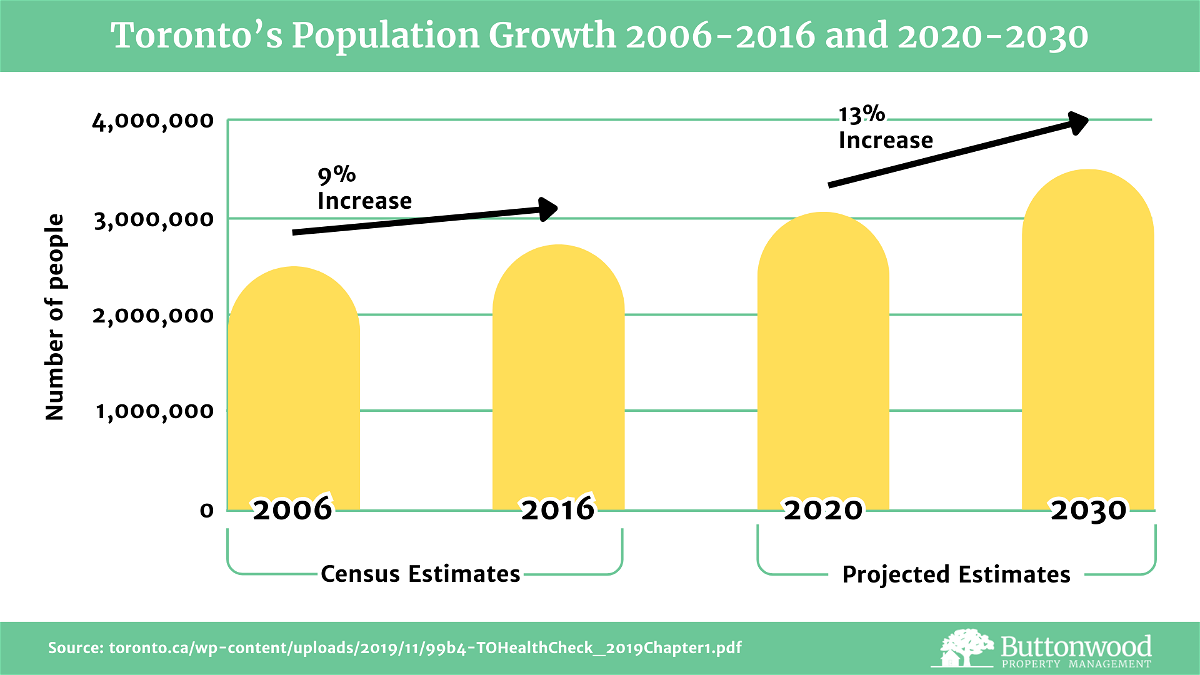Toronto, Ontario, is booming, witnessing an influx of domestic and international residents planting their roots and calling the city home for the foreseeable future.
Even before the pandemic, Toronto had experienced a strong increase in new residents, with the city adding close to 46,000 new residents in 2019. Between 2020 and 2021, Toronto was dubbed as one of the fastest-growing cities in North America, outpacing even the largest U.S. cities, including Chicago and New York City, respectively.
Key Takeaways:
- Toronto’s population is expected to reach nearly 3 million by 2025
- The city is a multicultural metropolis, with immigrants making up nearly half of all new residents
- Public and private investment is helping create new employment opportunities for individuals and businesses
- A housing crisis and high cost of living could slow growth and foreign interest
Much like Canada, Toronto has become a magnet for international residents moving here due to progressive immigration policies, favorable laws, fair taxes, and better access to public services, including schools, universities, and a colorful community of entrepreneurs taking advantage of the near endless economic opportunities the city has to offer.

Current estimates project that more than 2.6 million people will be living and working in Toronto by the end of 2024.
The city is quickly climbing the ranks as being not only the biggest and fastest growing urban metropolitans in North America but is boasting an array of multi-cultural attractions and dynamic economic developments.
Figure 1: Projected population Growth of Toronto 2006-2016 & 2020-2030.
Source: City of Toronto.
How Toronto Became The Biggest And Fastest Growing City
Since its founding in 1793, Toronto, known back then as the Town of York and the capital of Upper Canada, served as an important and valuable link between greater North America, Britain, Europe, and the 13 original colonies of the United States of America.
While the history of Toronto is nothing short of complicated and interesting, throughout the centuries, the then-small port village had undergone tremendous industrial and urban expansion throughout the various technological and economic revolutionary periods.
By the early 1800s, the extension of the Oswego helped to connect southern Ontario to New York City, helping to transform Toronto into a major point of imports and exports for local merchants and further cultivating an everlasting relationship between Canada and the U.S. The connection not only helped to transfer goods across the water faster but also helped to improve communication between the two countries and boosted agricultural expansion across the city.
It wasn’t until after the Second World War, and late into the 1960s, that Toronto’s economy began to move away from more traditional industrial activities, and started diversifying economic opportunities for local residents.
Already by 1976, Toronto surpassed Montreal as Canada’s largest and fastest-growing city following the amalgamation of 13 adjacent boroughs, and an additional five boroughs by late 1998. By the turn of the century, the City of Toronto limits were set, and development quickly began to sprawl outwards and upwards to keep up with rising demand.
Already by 2015, Toronto’s population and skyline were beginning to change dramatically. More than 40 skyscrapers, rising above 500 feet had already been built, and the city quickly became known as one of the most diverse metropolitans in North America.
Census data showed that in 2010 more than half of city residents – Torontonians – were born outside of the country, and were classified as a “visible minority.” Today, development continues to move at a rapid pace, seeing more people moving to the city, and higher, more modern skyscrapers acting as the backdrop to some of Toronto’s most historic buildings and neighborhoods.
Money Matters In The City Of Toronto
Strategic economic policies and legislation have helped Toronto remain at the top of being one of the fastest-growing cities, globally. Not only this, but these developments have helped to fund continuous investment in public infrastructure, allowing the city to create more jobs and lucrative opportunities for residents.
One of the key sectors that has played a pivotal role in Toronto’s economic diversification is the introduction of technology, an economic sector that is witnessing tremendous growth across the world.
The local tech sector has helped carry the brunt of the city’s growth in recent years, adding 88,900 new full-time jobs in 2021 according to data by CBRE. During this period, the city experienced stronger growth in the local tech sector compared to New York, Seattle, and Boston combined.
Many argue that the province has leveraged the key advantages of attracting international skilled workers to the city through Canada’s progressive immigration laws. The local legislation assists with the arrival of skilled and diverse technicians and provides a sustainable high quality of living.
More than this, hiring new employees in the tech sector is nearly 50% more affordable than compared to places such as San Francisco. Additionally, experts claim that Toronto not only has a better quality of living but doing business here is more affordable, which is helping to attract key investors.
Construction is considered another key sector of economic vitality. Public infrastructure investment has meant that expansion of local transportation systems, such as Union Station, considered to be Canada’s busiest multi-modal passenger transportation hub, has undergone tremendous redevelopment in recent years, majority funded by public investment.
Similarly, private developers have stepped up to help revitalize the city in more ways than possible throughout the year. Current improvement projects at Toronto’s waterfront district are one of North America’s largest urban renewal projects, which sees the transformation of a former 69-acre social housing development built into a self-sufficient mixed-income and multi-use community.
Both public and private industries have played a vital role in helping edge Toronto’s local economy forward, allowing residents to have access to better housing, improved public transportation options, and revitalizing the city to help establish a prosperous community and economy.
Toronto As A Multicultural Playground
Becoming one of the most diverse cities in the world isn’t possible without a mix of local and international residents helping to transform Toronto into the dynamic and sophisticated city it is today.
Canada’s historically high immigration targets have meant that many cities across the country can fully leverage the abilities of highly skilled individuals, and help to plug the shortage of critical skilled workers in the domestic labor market.
Currently, Canada aims to welcome roughly 485,000 new permanent residents in 2024, and 500,000 in 2025. Across the country, new permanent residents play a vital role in helping to keep Canada’s economy moving forward, while cities and surrounding regions help to record a surge in immensely diverse populations.
Being a city that attracts thousands of new residents each year has been the subject of contention, as local developers, community members, city planners, and residents are becoming increasingly concerned regarding land zoning regulations for higher-density development to sustain the growing population.
Cultural and social investment have made Toronto stand out against other North American cities, seeing the addition of Love Park, and the $400 million investment of the St. Lawrence Centre for the Arts improvement project being one of Canada’s first carbon-neutral theaters, which is estimated to open in 2028.

Figure 2: Projected growth of immigrants as share of Canadian population from 1871 – 2041.
Source: New Canadian Media
Despite the property and development boom, lingering concerns regarding architectural integrity, quality of construction, and sustainability remain at the top of priorities city officials are looking to achieve more effectively.
Fortunately, commercial and residential property management in Toronto has seen strong improvements over the last several years, ensuring effective real estate investment property management for investors and local buyers.
For property owners that have rental properties, rental management in Toronto is more than collecting rental income each month or overseeing several important duties. Property management services can help source the right tenants, assist with marketing a property, and lighten the legal burden of having a rental property.
More than this, property management companies in Toronto can help oversee the maintenance and upkeep of rental units and buildings. By employing the right people, renters, buyers, and owners can be certain that the overall integrity of a building can be protected, including architectural integrity, which plays a key role in the development of neighborhoods and the preservation of historical buildings.
These are only a handful of the necessary services that commercial and residential property management companies in Toronto cover. Due to the influx of new residents moving to the city, many would-be buyers and current property owners are partnering with management agencies to help lessen their burden and provide more convenient services for tenants.
Unfortunately, affordability has become another lingering concern for many people, not only new permanent residents but for local residents who have largely been priced out of the local real estate market due to rising costs, higher interest rates, and stronger demand.
A report by Urban Toronto indicated a decrease in new development applications submitted to the City of Toronto, with roughly 317 new applications submitted in 2022, a decline of 7.5% compared to 405 a year earlier.
The long-term impact of this decline remains to be seen, however, local governments are trying to push forward with providing more affordable housing developments and introducing several new laws that could limit domestic and international investors from buying up property, and causing further disruptions in the supply chain.
Toronto In The Spotlight
Comparing Toronto against other cities in North America isn’t an easy task, considering the amount of cultural, social, and economic elements you will need to factor into the equation.
However, based on the economic and cost of living, Toronto seems to stand out against its nearest contender, Vancouver. While renting and buying property in both these cities remain historically high, Toronto is seemingly more affordable in terms of cost of living, offering residents a more attractive real estate market.
Similarly, income and wages are roughly the same in Toronto compared to Vancouver, with the average livable wage in Toronto being $25.05 per hour, while being slightly higher at $25.68 in Vancouver.
Additionally, the city is acclaimed as being one of the most welcoming places for new residents, including international workers and immigrants. Some data shows that non-Canadian citizens account for 17.2% of the city’s total population in 2021. More than this, immigration in the city has been moving upward over the last several decades, growing from 123,000 new permanent residents in 2001 to roughly 160,000 in 2021.
The ability to carefully blend both Canadian and international cultures has made Toronto not only an immigrant-friendly place to live, work, and study, but the ability to cater to the needs of people and help them build a sustainable life here has made Toronto one of the best places to live when moving to Canada.
Despite being a welcoming city, problems regarding the high cost of living, interest rates, and unaffordable housing remain among the biggest problems many current and new residents are having to face.
To counter rising property prices across the country, the federal government passed the Prohibition on the Purchase of Residential Property by Non-Canadians Act in 2022. The new law would prohibit non-Canadian residents and foreign property investors from buying residential property in Canada.
The ban on foreign ownership of Canadian housing and real estate is currently set to expire by the start of 2025, however, recent legislation changes have now extended that ban until 2027.
The law was designed to help ease the burden of property management fees, home rental management, and skyrocketing housing prices many would-be buyers and renters experienced across the country. However, it’s still not clear how successful the prohibition has been, and whether it’s made a significant impact on local real estate prices.
Elsewhere in the beginning of 2024, the Canadian federal government has approved new legislation that would impose a two-year cap on new international student permits.
The new laws would reduce the intake of international students by 35% to 360,000 by 2026. These changes would make it harder for international students to legally live and work in Canada post-graduation, and would further discontinue work permits for some students.
Changes to these immigration policies come as a way to help ease the burden of the housing shortage, something that has been witnessed across the country, including in cities such as Toronto.
New requirements could mean that many of the country’s largest institutions could see a sudden decline in international students, a vital source of skills for many colleges, universities, and other top Canadian institutes.
This would not only have an impact on the country’s economy but could potentially deteriorate Canada’s reputation for being an open, inclusive, and diverse nation that has largely been built through the knowledge and skills of immigrants.
Toronto In The Future
Much to the imagination, Toronto is a city that continues to surpass everyone’s expectations, helping to bridge the divide among its residents, and creating a surplus of new opportunities for residents and internationals.
While not everything is without its challenges, Toronto is a city that carefully blends both the rich cultural history of Canada and the local region, while keeping its eyes on the future and enabling residents to create a modern city that leads as a global capital of progressive innovation.
Toronto is a place that helps to inspire other cities, acting as an example of the amount of planning and meticulous consideration needed to build a modern city that is not only as diverse as its residents and those that came before it, but acting as a precedent of what the city of tomorrow can become with the right leadership and people’s willingness to adapt to change.

Figure 3: Average property sale price in Greater Toronto Area 1996 – 2023.
Source: Move Smartly

